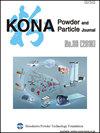多面体DEM的室内磨机实验验证
IF 3.2
4区 材料科学
Q3 ENGINEERING, CHEMICAL
引用次数: 1
摘要
用离散元法(DEM)对磨机进行数值模拟已取得了一定的进展。首先,它是作为一种研究球形球的电荷运动和预测磨机功率消耗的方法出现的。随后,利用三维DEM模拟了椭球和多面体颗粒对衬垫磨损、电荷运动的影响。此外,在DEM算法中计算的冲击能谱导致了磨机脆性颗粒破碎模型的发展。在这样的模拟的核心要素是颗粒的形状在轧机装药和轧机的功率消耗由于操作变量。为了推进这一领域,我们提出了一组90 × 13 cm轧机的实验数据和相应的DEM验证结果。DEM算法采用体积重叠法,对多面不规则粒子碰撞更为逼真。此外,我们使用岩石介质的扫描形状和研磨介质的多面球形形状来尽可能接近磨机中的实际装料。首先,对纯球磨介质实验、纯岩石实验、纯球磨介质与岩石混合实验以及仅代表颗粒形状主题的铝立方体实验进行了DEM验证。最后,对四种实验模式下的接触力学参数进行了讨论。由于给矿到工厂规模磨机的形状可能会有所不同,因此具有典型颗粒扫描形状的磨机模拟是未来更准确的结果。本文章由计算机程序翻译,如有差异,请以英文原文为准。
Verification of Polyhedral DEM with Laboratory Grinding Mill Experiments
The simulation of grinding mills with the discrete element method (DEM) has been advancing. First, it emerged as a method for studying charge motion with spherical balls and predicting the power draw of the mill. Subsequently, studies on liner wear, charge motion with ellipsoidal and polyhedral shaped particles simulated with three dimensional DEM followed. Further, the impact energy spectra computed in the DEM algorithm is leading to the development of models for the breakage of brittle particles in mills. The core elements in such simulations are the shape of particles in the mill charge and the power draw of the mill due to operating variables. To advance the field, we present a set of experimental data and the corresponding DEM validation results for a 90 × 13 cm mill. The DEM algorithm uses the volume-overlap method which is more realistic for multifaceted irregular particle collisions. Further, we use the scanned shape of the rock media and multifaceted spherical shape for the grinding media to represent as close as possible the actual charge in the mill. First, we present DEM validation for spherical grinding media-only experiments, rock-only experiments, and a mixture of spherical grinding media and rocks, as well as aluminum cubes only to represent the theme of particle shape. Finally, a discussion of the contact mechanics parameters in the four modes of experiments is given. Since the feed ore to plant scale mills can vary in shape, mill simulations with scanned shape of typical particles are the future for more accurate results.
求助全文
通过发布文献求助,成功后即可免费获取论文全文。
去求助
来源期刊

KONA Powder and Particle Journal
工程技术-材料科学:综合
CiteScore
8.40
自引率
4.90%
发文量
35
审稿时长
>12 weeks
期刊介绍:
KONA publishes papers in the broad field of powder science and technology, ranging from fundamental principles to practical applications. Papers describing technological experience and critical reviews of existing knowledge in special areas are also welcome.
 求助内容:
求助内容: 应助结果提醒方式:
应助结果提醒方式:


